I am a member of the Dutch association of wine connoisseurs (Verenigde Vinologen Nederland). As a member of the travel committee of the VVN, I organize wine trips to Italy together with Fred Nijhuis. This is the third day of our tour of Friuli. Click here for my account of our first day and here for the second day.

This third day we are visiting Brda in Slovenia. Historically, Collio and Brda are one wine region. Brda is the Slovenian word for Collio (hills) and the grape varieties are also the same. Rebula = Ribolla Gialla, Karst Teran = Refosco dal Peduncolo Rosso, Malvazija = Malvasia Istraiana, and Pokalca/Crna Rebula = Schioppettino. The Italian Gambero Rosso has even handed out 4 tre bicchieri awards to Slovenian wines from Brda. Brda has the same terroir as Collio, but it is called opoka here instead of ponca. Brda is a bit more hilly than Collio, with steeper hills and higher altitude (up to 800 metres (2600 ft) above sea-level). Brda has 1900 ha of vineyards (4700 acres), and about 28% of the workforce is active in the wine industry. Just like Collio, the climate is dictated by the location between the Alps and the Mediterranean Sea, and the associated wind called Bora.
Marjan Simčič

We start our tour of Brda at Marjan Simčič, probably the most famous family-owned winery in Brda. We were shown around by Valerija Simčič and Miha Ritonja, the wine maker. The vineyards are at an altitude of 120-270 meters (400-900 ft) above sea-level, part in Italy and part in Slovenia. They produce 120,000 bottles per year from 25 ha (60 acres) of vineyards, of which 15 ha in Slovenia. Because of the historical precedent, the wine is allowed to be called Slovenian even though some of the grapes are grown just across the border in Italy. The vineyard with old vines of Friulano is 97 years old. Friulano is called Sauvignon Vert (the French name) in Brda, as it is not allowed to be called Friulano as that name is reserved for the Italian wine of that grape. Simcic have their Sauvignon Vert and Pinot Grigio in the Italian part, the other varieties in Slovenia. Simcic had a difficult time during the Yugoslavian regime, as a family business aiming at quality instead of quantity did not fit into the model of cooperatives that have to produce as much as possible. Valerija shared an anecdote that it was only possible to import a wine bottling machine from Italy by listing it as a milk bottling machine in the paperwork. From 2006 Simcic started to produce ‘cru’ wines from single vineyards on opoka soil.
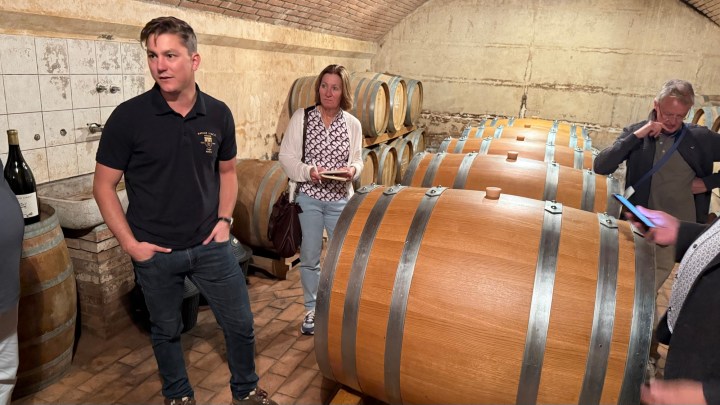
Wine maker Miha showed us around the cellar. He told us that all the grapes are hand picked and that minimum intervention is used for wine making. As the vineyards are all within 2 kilometers (1.2 miles) from the cellar, they use a small trailer to transport the grapes to the cellar without damaging them. After the first selection in the vineyard, a second selection is done in the cellar with an automatic destemmer and berry selector. They typically produce only 1 kilo (2.2 lbs) of grapes per vine. The 25 hectares are divided into 47 individual vineyards, which all require individual treatment. The five best plots with opoka soil are used for the top wines. At the top of the hills the soil is thin, so the vines have to work harder. This leads to small yields and thus high quality. Simcic has been shortening the skin contact (which is common in Brda) to avoid too much tannin in the wines. They use spontaneous fermentation, but with temperature control.

The egg-shape of the barrels causes a natural movement, such that no battonage (stirring) is needed. You mostly see concrete eggs, but there are also clay, terracotta, concrete, steel, and wood.
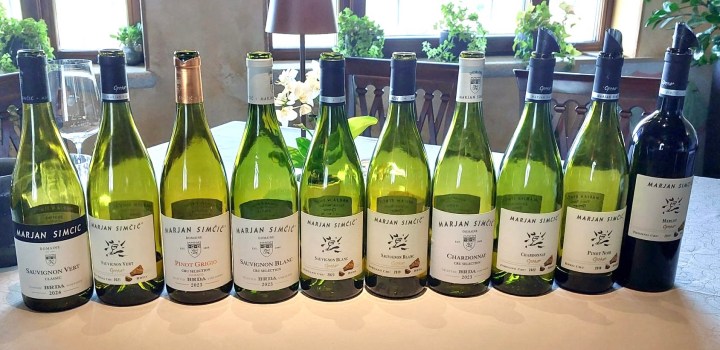
We tasted these wines at Marjan Simcic, all of a very pure and clean style:
- Sauvignon Vert Brda Classic 2024 (younger vineyards, flat, clay soils, made in stainless steel): mineral, elegant, sage.
- Sauvignon Vert Opoka Ronc Zegla Cru 2021 (oldest vineyard in the region, 2 years in barrel): mineral, elegant, concentration, balance.
- Pinot Grigio Cru Selection 2023 (47 years old vineyard): copper color, like a very elegant delicate rosé.
- Sauvignon Blanc Cru Selection 2023 (1 year oak): sage, balance, body, not very aromatic for a SB.
- Sauvignon Blanc Opoka Jordano Cru 2023 (few hours skin contact, 1 year oak, north-facing vineyard): sage, elegant, balance, fresh.
- Sauvignon Blanc Opoka Jordano Cru 2019 (4 days skin contact): developed, structure.
- Chardonnay Cru Selection 2023: crisp, balance.
- Chardonnay Opoka Jordano Cru 2022: buttery, structure, body, balance, long finish.
- Pinot Noir Opoka Medana Breg Cru 2018 (east exposure, 2.5 years in barrel): ripe but present tannins, ripe cherries, elegant, balance.
- Merlot Opoka Trobno Cru 2019: tannins, elegant, earthy.
Klet Brda
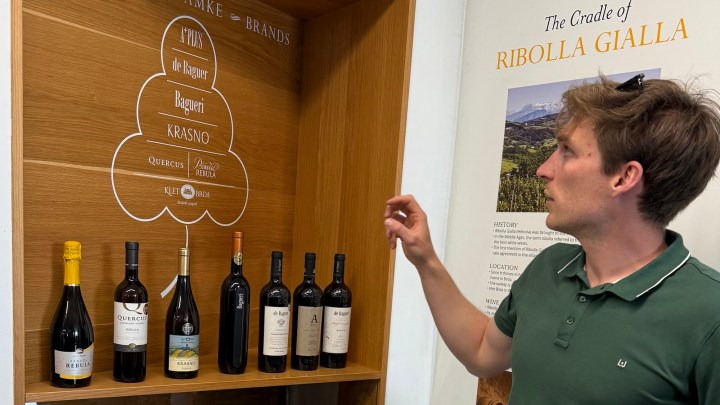
Our next visit was to Klet Brda, the cooperative winery of the region. It has 300 members and produces wine from 900 ha (2200 acres), half of the entire region. They produce 5 million litres of wine per year at different levels of quality. The Klet Brda brand is for supermarket wines. Above that are Quercus for fruity wines made in stainless stell, and Peneca sparkling wines. The next level up is Krasno, aged in large oak and steel barrels. Then at the top is de Baguer, aged in barriques and named after De Baguer, a Catalonian count who planted the first post-phylloxera vines in Brda in 1881. 70% is white from Rebula, Chardonnay, Sauvignon Blanc, Malvasia, and Sauvignon Vert (Friulano). 30% is red from Merlot, Cabernet Franc, and a growing amount of Pinot noir. We were received by Luka Ribolika, wine maker and son of the chief wine maker of Klet Brda (and with a last name that sounds a lot like Rebula).

During the tour of the cellar we saw this special production method for Rebula. They use skin maceration for 1 week, and then on top of that put 10-20% of whole berries inside the barrel for carbonic maceration for 1 year. After that year, the grapes come out completely dried out.
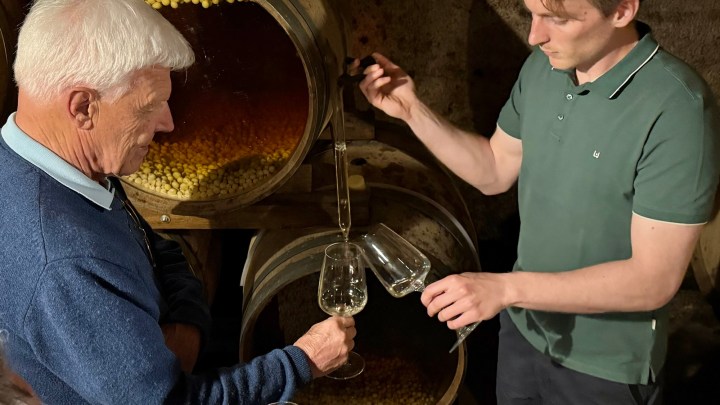
We tasted a barrel sample of this wine, in which you could clearly taste the extensive skin contact.

After the cellar tour it was time for tasting wines from Klet Brda, all with an outstanding price to quality ratio:
- De Baguer Virgo Zero Dosage (classic method 36 months on the lees, Brut Nature, 70% Chardonnay, 25% Pinot Noir, 5% Rebula): fresh, mineral, brioche, dry.
- Quercus Pinot Grigio 2024 (stainless steel, 6 months on the lees): very slight copper color, soft, fruity, peach, touch of residual sugar (2.5 grams/liter).
- Krasno White 2023 (60% Chardonnay, 30% Rebula, 10% Sauvignon Vert, 6 months in stainless steel on the lees, except for 30% of the Chardonnay in large oak barrels): balance, round.
- Krasno Rebula 2022 (aged in large oak barrels for 2 years, partial malo): structure, balance, mineral.
- Bagueri Piniot Grigio Ramato 2022 (48 hours skin contact, aged 12 months, 20% in oak barriques with malo, 80% in stainless steel): structure, peach, balance.
- Bagueri Chardonnay 2020 (aged in barriques for 1 year of which 20% new with stirring of the lees): oak (needs some more time in the bottle), structure, balance.
- De Baguer Chardonnay Sauvignon Blanc 2019 (70% Chardonnay, 30% Sauvignon Blanc, aged 12 months, the Chardonnay in oak barriques (60% new) and the SB in stainless steel, both with stirring of the lees): aromatic, creamy, structure.
- A+ White 2018 (50% Rebula (large oak), 40% Chardonnay (barrique), 10% Picolit (stainless steel)): golden, structure, complex.
- Krasno Red 2022 (40% Cabernet Sauvignon, 40% Cabernet Franc, 20% Merlot): fresh, elegant, tannins still astringent.
- De Baguer Red 2018 (70% Mertlo, 30% Cabernet Franc, 2 years in oak barriques (40% new), then after blending 1 more year in large oak): elegant, nice tannins.
- A+ Red 2019 (50% Merlot, 25% Cabernet Sauvignon, 25% Cabernet Franc): tannin, fresh, pencil.
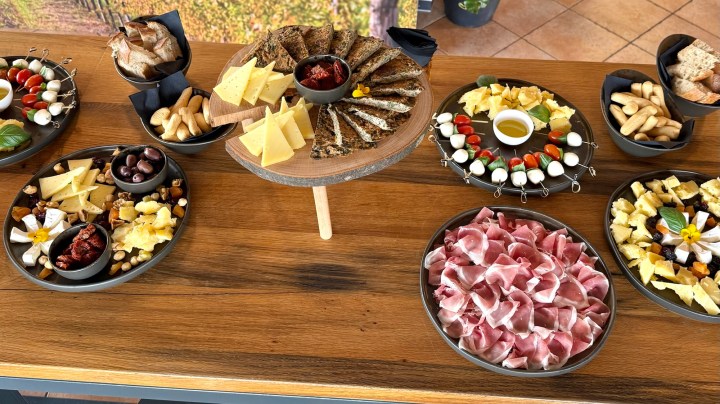
After the tasting we had a nice lunch of local salumi and cheese, but also a local omelet with herbs called frtalja.
Home of Rebula
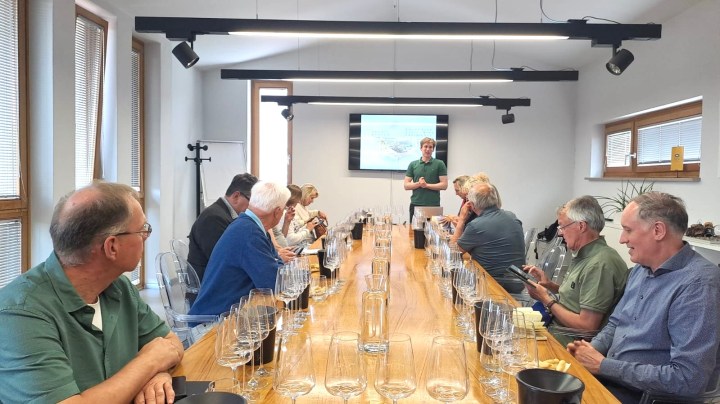
After lunch Luka provided us with a masterclass about Rebula from the Home of Rebula consortium. Although Rebula/Ribolla Gialla can of course also be found on the Italian side, it is considered to be the main grape variety of Brda (whereas for Friuli that is the Friulano). Rebula is the most important grape variety in Brda, covering over 25% of vineyard area. It is an indigenous grape variety resilient to climate change. Historical evidence of Rebula grapes dates back to Roman times. There are three main styles of Rebula wines:
- Classic Rebula is fresh and fruity (peach, apple, citrus), with vibrant acidity. It is aged in stainless steel or large oak barrels (6–18 months).
- Mature Rebula is complex, elegant, with ripe flavors and minerality. It is aged in oak or concrete tanks (18–36 months).
- Extended Skin Contact Rebula (Orange Wines) have a rich structure, tannins, and intense aromas. They are produced with a long maceration, and aged up to 10 years.
The vintages that we tasted during the masterclass can be characterized as follows:
- In 2024, extreme weather events such as spring frost, hail, and summer drought led to a lower yield but more concentrated grapes.
- The 2023 vintage experienced high temperatures and heavy rainfall, resulting in vigorous vine growth and large grape clusters.
- 2022 was a dry and cool year with stable temperatures, producing a small but highly concentrated harvest.
- The 2021 harvest benefited from dry conditions during ripening and large day-night temperature swings, yielding small berries and lower volumes.
- 2020 had a warm climate with well-distributed rainfall, supporting healthy berry development and good concentration.
- In 2019, warm conditions and evenly spaced rainfall led to a slightly reduced yield, about 10% below average.
- 2018 was a warm year with sufficient rainfall, resulting in a notably abundant harvest—30% above the average.
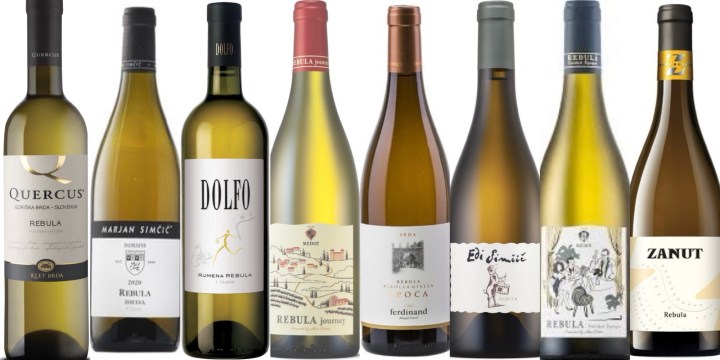
Classic Rebula:
- Klet Brda Rebula Quercus 2024 (hand-harvested from sustainable vineyards and cool-fermented in stainless steel tanks without oak aging): peach, crisp.
- Marjan Simčič Rebula Brda Classic 2024 (grapes are handpicked and vinified with a focus on freshness, using stainless steel or large oak casks): fresh, mineral.
- Dolfo Rumena Rebula 2023 (produced from old vines on opoka soil with a dry style and minimal intervention): almond paste, fresh, crisp.
- Medot Rebula Journey 2023 (48 hours of skin contact, steel, 10% oak): structure, elegant notes of peach.
Mature Rebula:
- Ferdinand Rebula Epoca 2022 (hand-harvested from older vineyards and matured in oak or concrete tanks for 18–36 months, malo, part new barriques): salty, restrained aroma, slightly creamy.
- Edi Simčič Rebula 2022 (fermented and aged for 11 months in French oak barriques): sulphur, salty finish, creamy.
- Medot Rebula Golden Epoque 2022 (12 hours of skin contact, 12 months barrique, 12 months large barrels): complex, structure and freshness, balance, restrained aroma.
- Zanut Rebula (2021) (cold-macerated on skins): earthy, fresh.
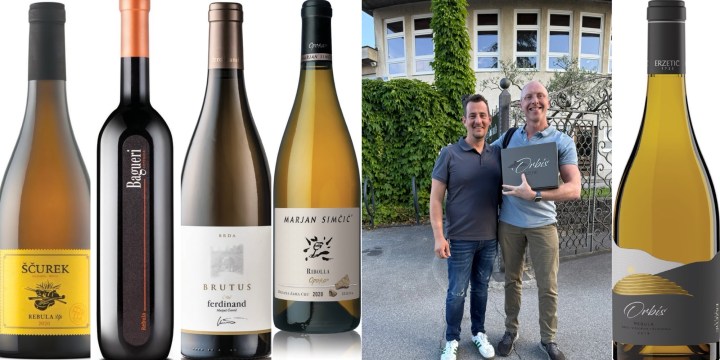
- Ščurek Rebula Up 2020 (late harvest, partial skin contact and aged in barrique with partial malo): golden, orange peel, oily, touch of residual sugar.
- Klet Brda Rebula Bagueri Superior 2020 (partially skin-fermented, part barrique, part stainless steel): oak, structure, complex, salty finish.
- Erzetič Orbis Rebula 2019 (24 hours cold maceration, aged 12 months in five different types of wood: oak, mulberry, wild cherry, ash, acacia): wood, creamy, complex, balance, structure, full-bodied, beautiful.
I liked the Erzetič Orbis Rebula so much that I was really happy that I met Andrej Erzetič after the masterclass and could buy a case from him; he phoned his sister to bring a case to us.
Extended Skin Contact Rebula:
- Ferdinand Rebula Brutus 2019 (destemmed berries are macerated for 12 months): astringent, cloudy, perceptible hint of acetic character in the aroma.
- Marjan Simčič Rebula Opoka Medana Jama Cru 2018 (produced from 68-year-old vines with 12-14 days maceration, aged 1 year in concrete eggs and 1 year in large barrels): dark golden, tannin, balance, restrained aroma, can age.
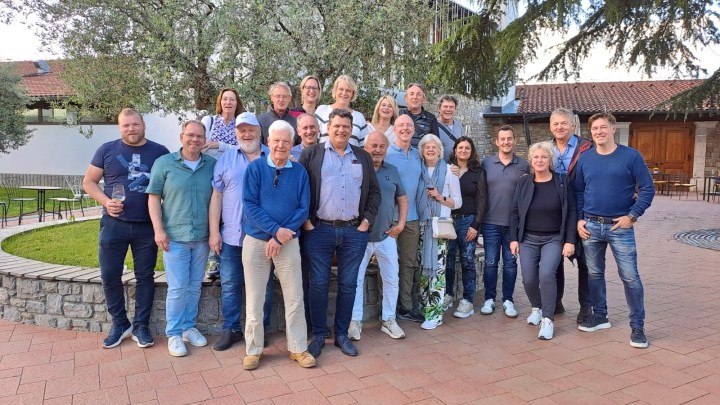
We ended our Brda wine experience by meeting some local winemakers from Zanut, Erzetič, Ščurek, Dolfo, and Ferdinand.
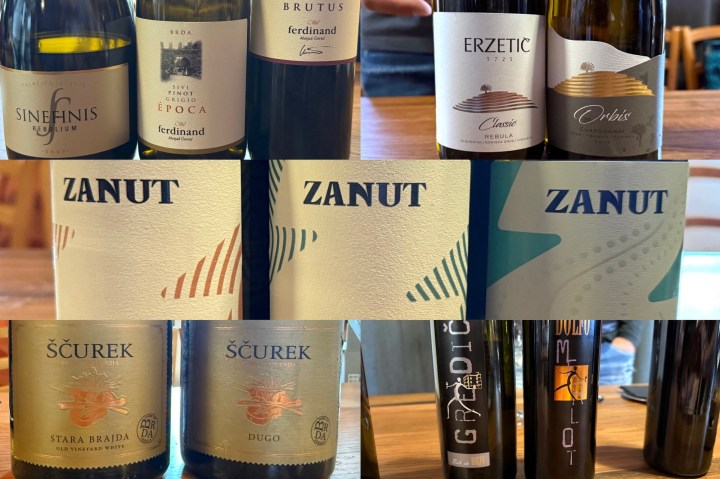
We also had an informal tasting of some of their wines. Besides Rebula there was also Chardonnay, Pinot Grigio, Sauvignon Vert, Verduzzo, Merlot, Schioppettino, and some white blends.
Hiša Marica
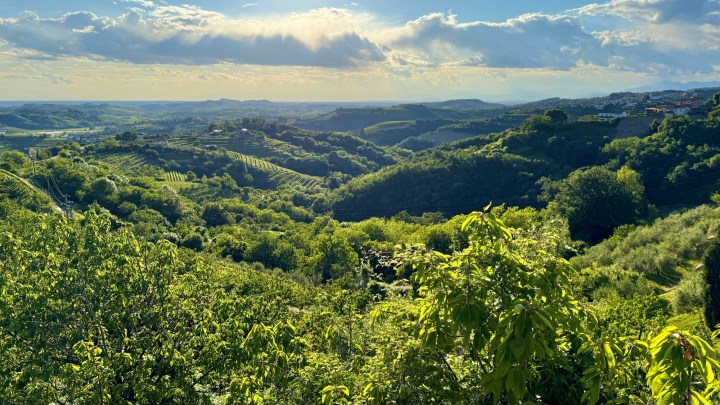
For dinner we went to the picturesque medieval village of Šmartno, on the top of a hill with a beautiful view.
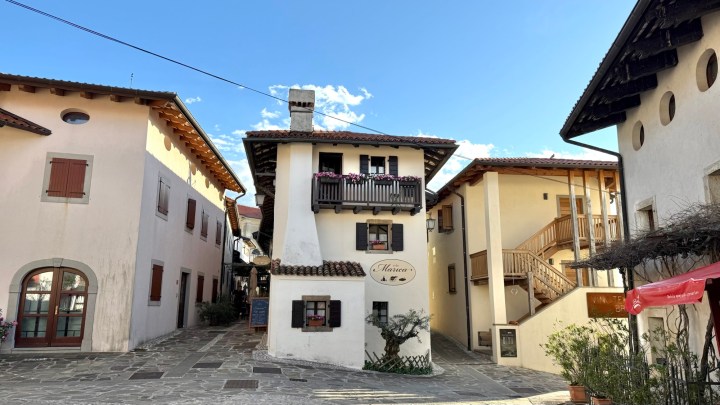
There we had dinner at Hiša Marica.
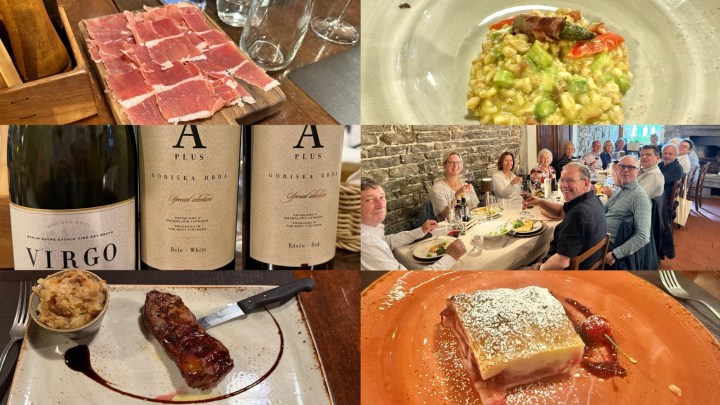
For dinner we started with Hiša Marica’s famous homemade prosciutto. Then we had spelt risotto with asparagus, datterino tomatoes, and pancetta. The main course was a Black Angus steak with nona Marica’s mashed potatoes. We ended with a cherry strudel. Cherries were in season, as we already noticed from the stalls selling cherries just outside the village. We had Klet Brda De Baguer wines with our dinner that we had already tasted earlier today at Klet Brda: Virgo Brut Nature, A+ White 2018, and A+ Red 2019.
This was a very nice day and a pleasure to meet young and talented wine makers Miha Ritonja and Luka Ribolica, who studied enology together at the University of Ljubljana. I am sure we will hear more about them in the future as they take wine making in Brda to new heights.


What a fascinating story to read even if one’s own wine knowledge and love are largely limited to ‘white’ and ‘red’ and ‘dry’ and no so 🙂 ! What absolutely beautiful countryside . . . undulating green has always made me most content! And how many of us reading and used to French and Italian and Spanish (and Australian) wines have even the slightest clue about what is such an important industry in Slovenia. It is mind-bending to read of cooperative wineries with 300 members in a country one was not even aware produced wine . . . oh, and methinks you did not starve either . . . please keep on writing and teaching . . . yes, I know such makes up your ‘memory notes’ but we get a chance to learn also . . .
LikeLike
Well it is an important industry in that part of Slovenia, which only has a population of 5,700. Slovenia has two wine regions and both are ‘continuations’ of a wine region that is now across a political border. The other one is Steiermark in Austria / Štajerska in Slovenia.
LikeLike